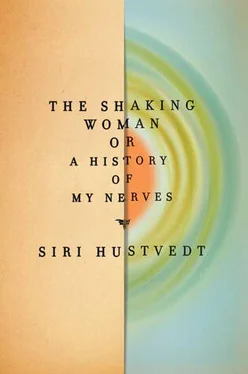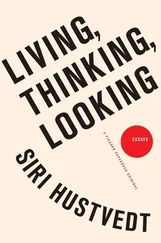51. Quoted in Feinberg, Altered Egos, 94.
52. Mark Solms and Oliver Turnbull, The Brain and the Inner World (New York: Other Press, 2002), 82.
53. M. S. Gazzaniga, J. E. LeDoux, and D. H. Wilson, “Language, Praxis, and the Right hemisphere: Clues to Some Mechanisms of Consciousness,” Neurology 27 (1977): 1144–47.
54. A. R. Luria and F. I. Yudovich, Speech and the Development of Mental Processes in the Child (Harmondsworth, UK: Penguin, 1971).
55. Davoine and Gaudillière, 115.
56. A. R. Luria, Higher Cortical Functions in Man, trans. Basil Haigh, 2nd ed. (New York: Basic Books, 1962), 32.
57. Sigmund Freud, Beyond the Pleasure Principle, trans. James Strachey (New York: Norton, 1961), 9.
58. Freud and Breuer, Studies on Hysteria, 49.
59. Ibid., 44.
60. Sigmund Freud, The Ego and the Id, trans. James Strachey (1923; repr., New York: Norton, 1960), 32–33.
61. Charles Dickens, David Copperfield (1850; repr., Oxford: Oxford University Press, 2000), 1.
62. Joe Brainard, I Remember (New York: Penguin, 1975), 28. Joe Brainard is known chiefly as a visual artist. He was part of the group of writers and painters known as the New York School, which included John Ashbery, Fair-field Porter, Alex Katz, Kenward Elmslie, Frank O’Hara, James Schuyler, Kenneth Koch, and Rudy Burkhardt. His work is in the Museum of Modern Art and the Whitney Museum. He died in 1994. I Remember inspired the French writer Georges Perec to do his own version of this memory-generating machine: Je Me Souviens .
63. Faraneh Vargha-Khadem, Elizabeth Isaacs, and Mortimer Mishkin, “Agnosia, Alexia and a Remarkable form of Amnesia in an Adolescent Boy,” Brain 117, no. 4 (1994), 683–703.
64. Ibid., 698.
65. Charles D. Fox, Psychopathology of Hysteria (Boston: Gorham Press, 1913), 58.
66. A. R. Luria, The Man with a Shattered World, trans. Lynn Solotaroff (Cambridge, MA: Harvard University Press, 1972), 92.
67. Quoted in Elaine Showalter, Hystories: Hysterical Epidemics and Modern Culture (London: Picador, 1998), 34.
68. Georges Didi-Huberman, Invention of Hysteria: Charcot and the Photographic Iconography of the Salpêtrière, trans. Alisa Hartz (Cambridge, MA: MIT Press, 2003).
69. Alan B. Ettinger and Andres M. Kanner, Psychiatric Issues in Epilepsy: A Practical Guide to Diagnosis and Treatment, 2nd ed. (Philadelphia: Lippincott, Williams & Wilkins, 2007), 471–72.
70. DSM-IV, 494.
71. Ibid., 496.
72. The experiences of soldiers with conversion disorder may shed light on one of the reasons women may be more vulnerable to hysteria than men outside of combat situations. If powerlessness and a feeling of having no active role in your fate are linked to the illness, then it makes sense that women, who have traditionally had far less autonomy than men, would suffer in higher numbers. Similarly, in many reference books, including the DSM, there is repeated speculation that hysteria is more common in uneducated people from developing societies, which seems to be another way of saying that people who feel their will is undermined by forces they don’t control may be more likely to succumb to a conversion.
73. C. S. Myers, Shellshock in France 1914–18 (Cambridge: Cambridge University Press, 1940), 42–43.
74. Edwin A. Weinstein, “Conversion Disorders,” http://www.bordeninstitute.army.mil/published_volumes/war_psychiatry/WarPsychChapter15.pdf, 385.
75. R. J. Heruti et al., “Conversion Motor Paralysis Disorder: Analysis of 34 Consecutive Referrals,” Spinal Cord 40, no. 7 (July 2002): 335–40.
76. DSM-IV, 467.
77. Trevor H. Hurwitz and James W. Pritchard, “Conversion Disorder and fMRI,” Neurology 67 (2006): 1914–15.
78. Goetz, Bonduelle, and Gelfand, Charcot, 178–79.
79. K. M. Yazici and L. Kostakoglu, “Cerebral Blood Flow Changes in Patients with Conversion Disorder,” Psychiatry Research: Neuroimaging 83, no. 3 (1998): 166.
80. Vuilleumier et al., “Functional Neuroanatomical Correlates,” 1082.
81. D. W. Winnicott, Home Is Where We Start From: Essays by a Psychoanalyst (New York: Norton, 1986), 32.
82. Vuilleumier et al., “Functional Neuroanatomical Correlates,” 1082.
83. Gallagher, How the Body Shapes the Mind, 41.
84. Karen Kaplan-Solms and Mark Solms, Clinical Studies in Neuro-Psychoanalysis: Introduction to a Depth Neuropsychology (New York: Karnac, 2002), 151–52.
85. Ibid., 190–91.
86. Ibid., 177.
87. Benjamin Libet, “Do We Have Free Will?” Journal of Consciousness Studies 6, no. 8–9 (1999): 47–57.
88. Julian Offray de La Mettrie, Machine Man and Other Writings, trans. and ed. Ann Thompson (Cambridge: Cambridge University Press, 1996).
89. Jaak Panksepp, Affective Neuroscience: The Foundations of Human and Animal Emotions (Oxford: Oxford University Press, 1998), 52.
90. Antonio Damasio, Descartes’ Error: Emotion, Reason and the Human Brain (New York: HarperCollins, 2000), 3–79.
91. William James, The Will to Believe and Other Essays in Popular Philosophy (1897; repr., New York: Barnes and Noble Books, 2005), 92.
92. Edmund Husserl, Ideas Pertaining to a Pure Phenomenology and to a Phenomenological Philosophy, Second Book, trans. R. Rojcewicz and A. Schuwer (Dordrecht: Kluwer, 1989), 19–20. I have simplified Husserl. We all have both Körper, a sense of our material selves, and Leib, an inner living awareness, but this distinction is enough to serve my purpose here. It seems clear, however, that in sickness the body becomes more thinglike. Its reality as not only Leib but also Körper is brought home.
93. D. W. Winnicott, “Mirror-Role of Mother and Family in Child Development,” in Playing and Reality (London: Routledge, 1989), 111.
94. Ibid., 112.
95. Ibid., 114.
96. Quoted in Allan Schore, Affect Regulation and the Origin of the Self: The Neurobiology of Emotional Development (Hillsdale, NJ: Lawrence Erlbaum, 1994), 76.
97. Ibid., 91.
98. Gallagher, How the Body Shapes the Mind, 73. Gallagher is strongly influenced by Merleau-Ponty, who in turn was influenced by Husserl. Husserl argues that we have a subjective conscious sense of our freedom to move, but that “the appearances that are arriving are already prefigured. The appearances form dependent systems. Only as dependent on kinaestheses can they continually pass into one another and constitute a unity of one sense.” The conscious is linked to a kinetic/motor bodily unconsciousness. See “Horizons and the Genesis of Perception” in The Essential Husserl: Basic Writings in Transcendental Phenomenology, ed. Donn Welton (Bloomington: Indiana University Press, 1999), 227–28.
99. V. Gallese, L. Fadiga, L. Fogassi, and G. Rizzolatti, “Action Recognition in the Premotor Cortex,” Brain 119 (1996): 593–609. Gallese’s ongoing research into the neurobiology of intersubjectivity is an interdisciplinary one that draws from psychology and philosophy as well as science. For an illuminating discussion of his position that intersubjectivity is primarily a pre-rational, embodied reality, also called intercorporeity, see Vittorio Gallese, “The Two Sides of Mimesis: Girard’s Mimetic Theory, Embodied Simulation and Social Identification,” Journal of Consciousness Studies 16, no. 4 (2009), 21–44.
100. G. W. F. Hegel, The Phenomenology of Mind , trans. J. B. Baillie, 2nd ed. (London: Allen and Unwin, 1949), 232.
Читать дальше












